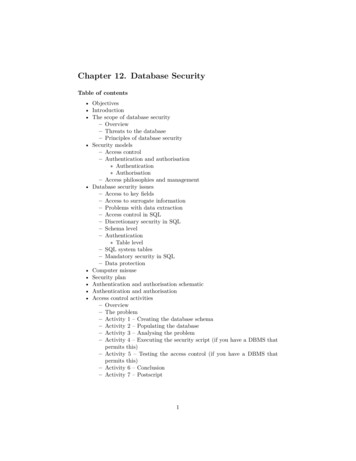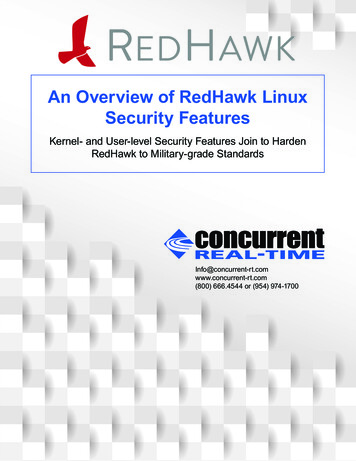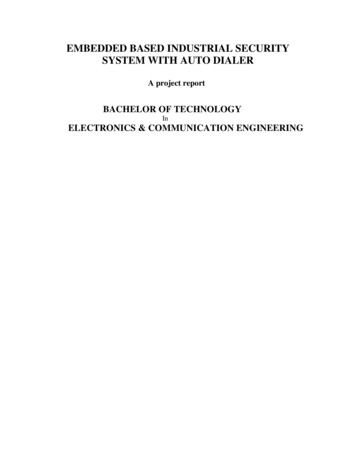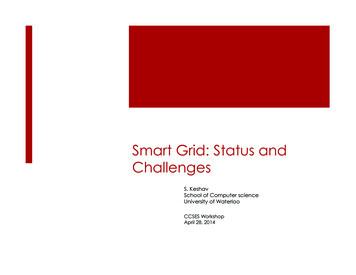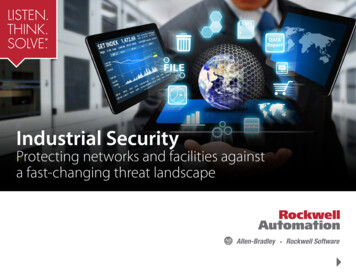
Transcription
Industrial SecurityProtecting networks and facilities againsta fast-changing threat landscape
Security in The Connected EnterpriseManufacturing and industrial facilities are operating in ways they scarcely could have imagineda few decades ago.Greater connectivity and information sharing – enabled by technologies such as smart devices, inspired by concepts likethe Internet of Things, and brought to life in The Connected Enterprise – are significantly transforming companies andtheir operations. They’re converging information technology (IT) and operations technology (OT) systems and using newtechnologies such as mobile, analytics, cloud and virtualization to do more than ever before.However, just as the nature of manufacturing and industrial operations has changed, so have the security risks. Moreconnected operations can create more potential entrance points for industrial security threats. These threats can come inmany forms – physical or digital, internal or external, malicious or unintentional.Industrial security must address a wide range of concerns, including: Safeguarding intellectual property and other valuable information. Protecting operations from intrusions that could impact productivity, product quality, worker safety or the environment. Maintaining critical systems that populations depend on, such as wastewater treatment systems. Achieving network availability and avoiding network-related downtime.What is TheConnected Enterprise?By converging historically separatesystems and connecting people,processes and technology acrossan organization, The ConnectedEnterprise creates new opportunitiesto access, share and act on data fromwithin your operations. Enabling, but also properly controlling, remote access to industrial operations.A 2014 Kaspersky Labs surveyrevealed 21 percent ofmanufacturers suffered anintellectual property loss withina one-year period.1“My biggest security concern is allowing a breach at a customer sitethat results in loss of safety.”– Engineering manager at an industrial manufacturing company1Kaspersky Lab Survey: One in Every Five Manufacturing Businesses Has Lost Intellectual Property to Security Breaches Within the Past Year, Kaspersky Labs, Aug. 13, 2014.2
A Holistic ApproachThe growing adoption of smart manufacturing and connected operationscombined with today’s highly robust threat landscape requires a renewedcommitment to industrial security.First, don’t succumb to paralysis from over analysis. It can be overwhelming to think of all thepossible threats. Instead, focus on the probable threats. This can help you more quickly andeasily begin implementing strong security practices.Also, avoid approaches that limit security: No single security product, technology or methodology is sufficient for today’sabundance of threats. A security-through-obscurity approach lacks meaningful measures. Proprietary networks rely on a single vendor and fall short when they don’t take advantage ofthe plethora of other IT tools, security features and innovations available from the marketplace.Industrial security must be holistic. It should extend from the enterprise through theplant level and even out to end devices, and address risks across your people, processes andtechnologies. It also should involve collaboration between IT and OT personnel. Both sides havevital roles to play in establishing a secure network architecture.Three key considerations for undertaking a holistic approach include:1. Security assessment: Understand your risk areas and potential threats.2. Defense-in-depth security: Deploy a multi-layered security approach that establishesmultiple fronts of defense.3. Trusted vendors: Verify that your automation vendors follow core security principles whendesigning their products.Basic cybersecurity practices within manyindustrial organizations continue to be anafterthought or significantly less than needed.11ICS Cybersecurity for the C-Level, U.S. Department of Homeland Security, September 2015.3
Security AssessmentDeveloping and implementing an effective industrial security program requires that you first understand the risksand areas of vulnerability that exist within your organization.A security assessment will help you understand your current security posture regarding your software, networks,control system, policies and procedures, and even employee behaviors. It should be the starting point for anysecurity policy.A security assessment’s deliverables should include at a minimum: An inventory of authorized and unauthorized devices and software. Detailed observation and documentation of system performance.How Secure is YourOrganization? Identification of tolerance thresholds and risk/vulnerability indications. Prioritization of each vulnerability, based on impact and exploitation potential.The final outcome of any security assessment should include the mitigation techniques required to bring anoperation to an acceptable risk state.Executive management shouldenforce the implementation ofsuitable security controls basedon risk assessments, and not toleratecybersecurity being sacrificed to the‘do not touch it’ attitude.1When it comes to security, there’s toomuch at stake to let your assessmentbe a guessing game. Whether you’reunsure of where to begin or lackin-house security expertise, considerusing outside services for help.The Rockwell Automation SecurityAssessment Tool is a free, secureand confidential tool that can helpyou identify your current risk level,benchmark it against other similarfacilities, and identify potentialmitigation methods.Rockwell Automation also offerssecurity assessments through itsNetwork and Security Services. Bycollaborating with strategic alliancepartners, including Cisco, Panduitand Microsoft, Rockwell Automationbecomes a one-stop shop for yourindustrial networking needs.1Cyber Security of Industrial Control Systems, TNO, March 2015.4
Defense-in-Depth SecurityIndustrial security is best implemented as a complete systemacross your operations.Defense-in-depth (DiD) security supports this approach. Based on the notion thatany one point of protection can and likely will be defeated, DiD security establishesmultiple layers of protection through a combination of physical, electronic andprocedural safeguards. Just like a bank uses multiple security measures – such asvideo cameras, a security guard and a vault – this helps make sure threats encountermore than one line of defense.A defense-in-depth security approach consists of six main components:1. Policies and Procedures2. Physical3. Network4. Computer5. Application6. DeviceBroad Support for Defense-in-DepthThe Defense-in-depth security approach is recommended in: IEC 62443 standard series (formerly ISA-99). NIST Special Publication 800-82. U.S. Department of Homeland Security/Idaho National LaboratoryReport INL/EXT-06-11478.5
Defense-in-Depth Security1. Policies and Procedures2. PhysicalPolicies and procedures play a critical role in shaping workers’ behaviorsto follow good security practices and confirming the appropriate securitytechnologies are used. For example, policies that control human interactionwith manufacturing and industrial operating systems can help preventinformation theft.Physical security should limit personnel access to not only areas of a facility but alsoto entry points on the physical network infrastructure, such as control panels, cablingand devices.At the facility level, access control technology such as networked key cards can helprestrict access to the plant floor, control rooms and other areas to authorized personnelonly. Cameras have long been used to monitor facility activities, but advanced videoanalytics solutions can protect sensitive locations and network access points in newways, such as through facial recognition, perimeter violations and thermal identification.The physical infrastructure and components, such as switches, routers and gateways,also must be protected against intrusions, tampering and accidents. Lock-out devicescan prevent unauthorized access to USB ports to stop the unwanted removal of dataand block potential virus uploads, while lock-in devices can prevent unauthorized cableremovals and keep vital connections in place.Only 20% of industrial companiessurveyed said they have strongphysical security policies.11TechValidate survey of Rockwell Automation customers, January 2016.6
Defense-in-Depth Security3. NetworkA network security framework should be established to help safeguard your network infrastructure againstcyberattacks. This requires close cooperation between IT and OT, including a robust discussion between the twogroups about the technologies and policies needed to best protect your assets and your ability to innovate.One of the technologies discussed should be an industrial demilitarized zone (IDMZ), which creates a critical barrierof protection between the enterprise and industrial zones. An IDMZ restricts traffic from directly traveling betweenthe two zones and can help better manage access through authentication enforcement or the monitoring of trafficfor known threats.“My biggest security concern is my company’s lack of knowledge andexperience in process control network security.”– Plant manager at an industrial manufacturing companyA Network Infrastructure’sRole in SecurityA unified network infrastructure is built ona physical network fabric and informationarchitecture that uses standard, unmodifiedEthernet and IP technology.Network infrastructures such as EtherNet/IP that use the Internet Protocol enableorganizations to take advantage of the latestwork being done by cybersecurity experts bothwithin and outside of the industrial sector.7
Defense-in-Depth SecuritySegmenting areas of the plant floor into virtual local area networks (VLANs) is a good securitypractice at the network level. VLANs are broadcast domains within a switched network. SmallerVLANs are easier to manage and maintain real-time communications. They can help isolate devicesfrom those that have been compromised, which keeps the negative impact within a single VLAN.Firewalls with intrusion detection and prevention systems (IDS/IPS) should be deployed withinand around the industrial network to manage and limit network traffic. Firewalls also should usedeep packet inspection (DPI) to identify, authenticate and re-route data to help improve networkperformance and reduce security threats.Lastly, it is important to follow security best practices when using wireless networks. This includesusing device-authentication and data-encryption methods that align with IEEE 802.11, which isincreasingly becoming the standard for deploying wireless networks in industrial applications.“Wireless is my biggest security concern because we’re using more andmore wireless devices and networks in our plant.”– Plant manager at a large chemicals companyResources Address Security RisksRockwell Automation and Cisco jointly developedthe Converged Plantwide Ethernet (CPwE)program, which includes best practices,recommendations and reference architectures.These resources provide the foundation fordesigning and deploying future-ready networkinfrastructures, as well as for managing networkaccess security and addressing unknown risks.Training, education and certification optionsare available for workers involved in managingnetwork infrastructure.8
Defense-in-Depth Security4. Computer5. ApplicationThe top means of intruder entry into automation systems is throughsoftware vulnerabilities.Security devices should also be incorporated at the manufacturing or industrialapplication level as part of a DiD approach.Security patch management should be established to track, evaluate, testand install cybersecurity software patches. Antivirus software, applicationwhitelisting and host intrusion-detection systems can further hardencomputer assets. Unused Windows programs, protocols and services shouldbe removed, and infrequently used USB, parallel and serial interfaces alsoshould be protected.A role-based access control system can restrict access to critical process functions orrequire operators to enter log-in information before they access applications. A securitylock on the controller can help prevent unwanted physical access, and authentication,authorization and accounting (AAA) software can restrict and monitor applicationaccess and changes. Tamper detection capabilities also can detect and record unwantedapplication modifications.Over half of industrial companies surveyedsaid their top security challenge in thenext three years will be enabling andcontrolling secure remote access.11TechValidate survey of Rockwell Automation customers, January 2016.9
Defense-in-Depth Security6. DeviceDevice authentication and unauthorized device identification can help make sureonly trusted devices are used.Additionally, changing the out-of-the-box default configurations for embeddeddevices can help make them more secure in areas such as restrictive access andchange management. For example, users can control which tags can be modifiedfrom HMIs and external applications, or define tags as constants, which cannot bemodified by controller logic.The default security settings will vary across devices, affecting how much time andeffort is required to harden each device.10
Trusted VendorsYour automation vendors are just as integral to helping you meet your security goalsas they are your production, quality and safety goals.Before selecting vendors, request they disclose their security policies and practices. Consider if they followfive core security principles – defined by Rockwell Automation – for designing products used in a control system:Secure NetworkInfrastructureAuthenticationand PolicyManagementVendors can helpkeep informationin the automationlayer secure andconfidential. Forexample, embeddedtechnology canvalidate andauthenticate devicesbefore they aregranted access toa network.ContentProtectionTamper DetectionBuilt-in tamperdetection can detectany unauthorizedsystem activityand alert the rightpersonnel. It also canlog key details, such aswhere the attemptedintrusion took place,how it occurredand if anythingwas modified.Intellectual propertyis the lifeblood ofyour operations. Yourautomation solutionscan help protect it byassigning passwordsto routines and addon instructions, andby using digital rightsmanagement to limitusers’ ability to viewand edit device data.Company policiesdictate data accesslevels for employees.Automation productscan support thesepolicies using accesscontrol lists to manageuser access to devicesand applications.Robustness00 1111 011 000 11 0010 10 10 01 00001 0 0 1 0 1 0 1 01 001 00 11 0011100110011001000010 1010010101010 00 101010101010 101000 101011010 1 0010 1000010101010011 0 1 010101100101 0 0 1 0 1 0 0 0 1 0 1 0 1100100101010011010111 0010001010101001010 010100010110 0 0010110100101101010101010100101011010 0 00 1 0 1 0 1 0 1 0 0 0 1 0 1 0 1 0 1 0 1 0 1 0 0 1 11 0 1 0 1 0 1101010101 0 1 0 0 111 0 1 0 1 0 1 0 1 0 1 0 1 0 1 0 1 0 0 0 1 0 1 0 1 0 1 010 001010101011010 0000101010101010100 1 0 101010 101010 1011 0 110101010A robust vendorsecurity approachincludes providingsecurity training toemployees; usingdesign-for-securitydevelopment practices;testing productsto global securitystandards; conductingfinal security reviews0 1are0 10 1products1 beforereleased; verifyingprocessesstay current0 1 1 1 0 1 0 1 0 1 00 1 0with standards and 1 0 1technologies; andhaving a plan inplace to addressvulnerabilities.1010110100101010 01010101010 0 01010101010 01010 0 010 1 0 0 111 01010101010101010010101010101010101010101010 0101A Better Way to Build TrucksDuring a plant upgrade, DaimlerTrucks North America (DTNA)used aspects of the ConvergedPlantwide Ethernet (CPwE) validateddesign guides from Cisco andRockwell Automation to jump startthe network architecture designand deployment.The new network provides secureand reliable Wi-Fi connectivityeverywhere on the shop floor andin office areas.Bringing its IT and OT departmentsmore closely together helpsDTNA meet its security andcompliance requirements.Now, one converged plant-tobusiness network provides secure,reliable connectivity everywhere.11
Monitor and EvolveSecurity threats aren’t relenting. They will only continue to evolve as the industry changes itssecurity practices or implements new defense. Your risk management strategy must keep pace.Your security program should have no end state. It should be ongoing, evolving with or ahead of the changing threatlandscape. Some tips for keeping your security program dynamic and relevant include: Educate your workforce: Security requires the support of everyone. Workers should be educated in areas such asavoidance techniques for dealing with phishing, USB devices and other security threats. Scrutinize your supply chain: Your vendors are just as vulnerable to security attacks as you are. Before selectingvendors, request they disclose their security policies and practices. Don’t wait for an alert: Cybersecurity threats are stealthy and designed to defeat a range of defenses. As a result, yoursecurity measures should be trusted but also verified. Routinely check audit logs, registry dates and time stamps forunexpected changes. Support security training: Knowledge is power for IT and security professionals. Provide the necessary investments ineducation, training and certification to help keep these workers up to date on security challenges and best practices. Evolve with technology: New technologies can have unique security needs. For example, mobile device managementshould be used to restrict access and monitor mobile access to the enterprise. Cloud computing services should offerproven security, such as through the Microsoft Azure platform.Symantec reported that morethan 317 million new piecesof malware were created in2014 – or an average of nearly1 million per day.112015 Internet Security Threat Report: Attackers are Bigger, Bolder and Faster, Symantec, April 14, 2015.Cloud SecurityM.G. Bryan, a heavy-equipmentprovider for the oil and gas industry,teamed with Rockwell Automationto develop a scalable solutionfor remote asset management offracturing vehicles.Using Microsoft’s WindowsAzure cloud-computingplatform combined with theFactoryTalk software suite fromRockwell Automation, M.G. Bryanhas enhanced, secure and instantvisibility into remote-asset data,which has improved uptime andproductivity for its customers.“It is important not to fall victim toa ‘my data needs to be behind adoor’ mentality,” said Josh Rabaduex,director of engineering for M.G.Bryan. “While the cloud can seemlike a virtual world, in many casesit can actually provide bettersecurity and redundancy than atraditional system.”12
SummaryThe vastness of today’s security threats combined with not knowing how, when or where anattack will occur can be daunting. The approaches outlined here will put you in line with bestindustry practices for securing your intellectual property, while also helping you protect yourfacilities, assets, employees and competitive advantages.Resources:Rockwell Automation provides a range of security solutions and services to help you managepotential security threats and build more secure industrial control systems and network architectures.Rockwell Automation Network and Security Services can help you whereveryou are in your security life cycle – from assessments and design to implementationand security monitoring.The CPwE reference architectures offer education, design guidance,recommendations and best practices for addressing security risks whilenavigating the IT/OT convergence process.Nearly two-thirds of industrialcompanies surveyed cite costjustifying and having adequateskills as their biggest fears aboutimplementing security solutions.1Industrial IP Advantage is an online community where best practices andresources are shared for using standard, unmodified Ethernet and InternetProtocol in industrial settings. It also offers e-learning for addressing securityand other key aspects of industrial networking.A Shared Commitmentto SecurityRockwell Automation haslongstanding strategic allianceswith industry leaders, such asCisco, Microsoft, AT&T and Panduit.Our complimentary offerings andcombined expertise can help youunderstand your unique securityneeds and integrate protection atevery level.The Rockwell Automation Security Assessment Tool is a free, secure and confidential tool thatcan help you identify your current risk level, benchmark it against other similar facilities, and identifypotential mitigation methods.1TechValidate survey of Rockwell Automation customers, January 2016.Allen-Bradley, FactoryTalk. LISTEN. THINK. SOLVE. and Rockwell Automation are trademarks of Rockwell Automation, Inc. EtherNet/IP is a trademark of ODVA Inc.Azure and Windows are trademarks of Microsoft Corporation. All other trademarks and registered trademarks are the property of their respective owners.Publication SECUR-WP004A-EN-E – July 2016Copyright 2016 Rockwell Automation, Inc. All Rights Reserved. Printed in USA.13
security assessments through its Network and Security Services. By collaborating with strategic alliance partners, including Cisco, Panduit and Microsoft, Rockwell Automation becomes a one-stop shop for your industrial networking needs. 1 Cyber Security of Industrial Cont
